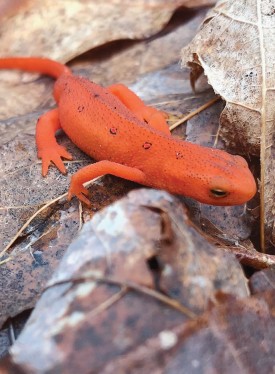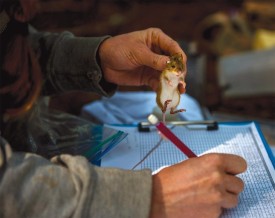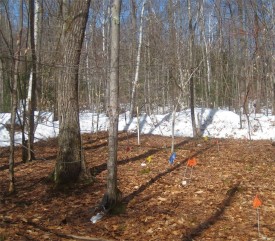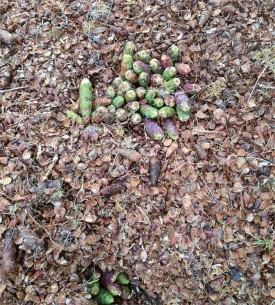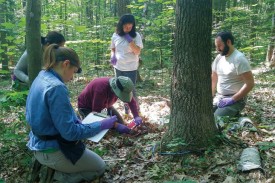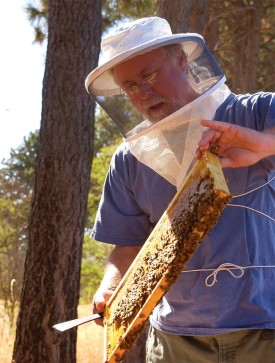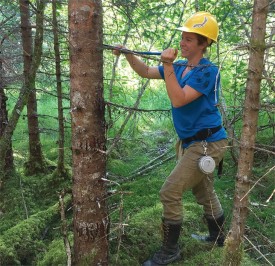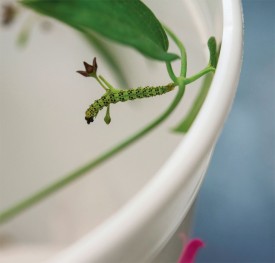Common green darners are among the largest dragonflies in the Northeast, and they are voracious predators, capturing large flying insects – including other dragonflies – while in…
Discoveries
Deadwood: Salvage or Let it Lie?
When the next major outbreak of spruce budworm strikes the forests of the Northeast, millions of acres of trees will be at risk. Nearly 100 million metric tons of stored carbon will also be at…
Fungal Disease Plagues Porcupines
Porcupines are quite common across the northern tier of the United States, but scientists at the New Hampshire Veterinary Diagnostic Laboratory have discovered a crippling fungal disease that…
Small Mammals, Big Personalities
The seed dispersal habits of small mammals have long been known to have a significant bearing on the health and growth of forests. A doctoral student at the University of Maine has found that…
No Snow, No Grow?
A team of researchers studying snowpack decline found that snowless winters leave trees stunted. In a series of forest manipulation experiments begun in 2007 at Hubbard Brook Experimental…
Changing Their Stripes
Jennifer Blake-Mahmud often thinks of plants and trees as being somewhat like Lego building blocks. Sometimes what they become looks nothing like the picture on the box. For instance, they…
Seed Money
Red squirrels store food in the ground that they can access whenever they need it. When they die, the squirrels typically leave large quantities of uneaten food behind that can be inherited by…
Tall Trees
For many years, scientists have wondered what factors influence how tall a tree can grow. Much of the research has focused on how high water can be transported internally from roots to leaves,…
Barriers Ahead
Climate models predict that certain tree species will likely migrate northward in the coming century. But two studies led by researchers from the National Park Service and the University of…
Swamped With Carbon
Biodiversity has long been known to be a significant factor in the amount of carbon stored in forests. Forests with many different species of trees store more carbon than forests consisting of…
Buzzing About Mushroom Medicine
Researchers in Washington have discovered that a mushroom extract may be an effective treatment for reducing levels of at least two viruses implicated in the collapse of honey bee colonies…
Giant Viruses of the Forest
Only a small fraction of the microscopic life that inhabits soil has been identified, which makes quantifying what’s out there nearly impossible. But a significant leap forward was made…
Reading the Rings
An investigation of 23,000 tree cores collected in the 1980s from forests throughout the Northeast has found that trees in the region show a strong ability to adapt to local climates. By…
Moose Mortality
The later start to winter in many recent years has provided winter ticks in northern New England with an extended period of time to find a host animal to feed on, and that appears to be the…
Zone Defense
A study of forest fragmentation by a team of researchers at the University of Maine has found that the zoning system used by the state to protect winter habitat for deer is not an effective…
Stopping Swallowworts
A new tool has been approved in the fight to control invasive pale and black swallowworts, and it’s a good sign for monarch butterflies. The natural enemy of the swallowworts is a Hypena…
A Salt Assault
The application of road salt to highways, sidewalks, and parking lots has resulted in improved winter driving and walking conditions. But salt is easily dissolved. It leaches into groundwater…
Troubling Trends for Urban Trees
Trees in urban areas provide tremendous benefits to society. They remove air pollution, reduce energy use, filter storm-water runoff, and reduce ultraviolet radiation. They also improve the…
Cankers Caused by the Climate
A native fungal pathogen that was once considered relatively harmless has become increasingly damaging to eastern white pines since the late 1990s, and stressed, weakened trees appear to be…
Rotten Luck
Most microorganisms that digest and recycle woody material do so by producing enzymes that accelerate chemical reactions to break down molecular compounds in the wood. Brown-rot fungi, the…


